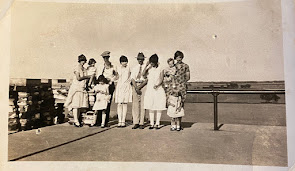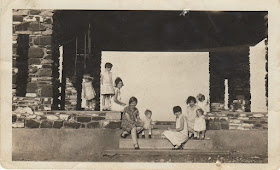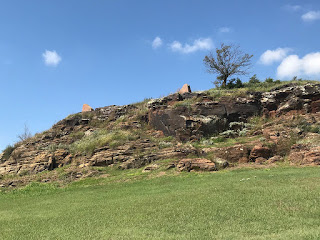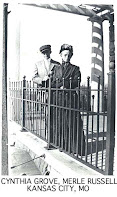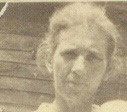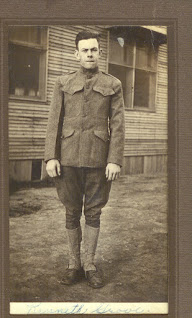In the summer of 1927, GC Wilkins, his wife Ora Roddy Wilkins and their four daughters, Mary 15, Jo 8, June 3 and Jane 14 mos. made a visit to Pawnee Rock Kansas. Pawnee Rock is a historic landmark on the Santa Fe Trail in present-day Barton County, Kansas. Located in the county’s southwest corner, the bluff, comprised of Dakota Sandstone, sits about 100 yards from the old Santa Fe Trail. Before this road was blazed, the large rock formation, rising out of the flat prairie, was a site where the Comanche, Kiowa, Arapaho, and Cheyenne Indians held councils of war and peace. In 1908, the remaining portion of the bluff was acquired by the Woman’s Kansas Day Club, and the next year it was turned over to the State of Kansas as a historic site. On May 24, 1912, a stone monument was dedicated with a great celebration before a crowd of some eight thousand onlookers. The state park today provides a road that leads to a shelter house and monument on the summit. An overlook, monument, and historical signs now grace its reduced summit, where visitors can stand, witnessing the view that so many throughout history have shared. The site is open from sunrise to sunset.
Tuesday, May 11, 2021
Tuesday, August 25, 2020
Russell/Grove Families and the 1918 Flu Pandemic
My first recollection of the mention of Aunt Cynthia Grove Russell was in 1962 when my paternal grandfather, John Edwin Grove, casually referred to her during a car ride return trip from Parker, KS to Wichita.
Parker was the hometown of my Grove ancestors and in 1962 we spent Memorial Day there (called Decoration Day by my grandparents). That visit was memorable as it is the first time I visited Goodrich Cemetery, the site of the graves of several generations of my Grove ancestors. It was also the first time my father, John Virgil Grove, pointed out to me his boyhood home on Taft St. in Parker.
On that car ride home, I started asking questions about the graves we had seen and how I was related to those Groves. In retrospect it was probably this trip that inspired my genealogical hobby.
My grandfather mentioned that the Russell graves we had seen were victims of the Spanish Flu. I knew flu as an illness but not a killer. So, I was curious how it caused death. My grandfather was 12 in 1918. He remembered his Dad’s sister Aunt Cynthia quite well and her children, Donald, Anna, Merle. By 1918 Cynthia had been a widow for 25 years. She was living in Kansas City and had become the matriarch of the Grove family.
Tragedy struck in January, 1918. Cynthia had moved from Parker to Kansas City where she died January 9, 1918 at age 64. According to her death certificate she had been sick ten days with catarrhal pneumonia. Aside from that her health had been good. Her son Donald Delos Russell, who also lived in Kansas City, became ill returning from the cemetery in Parker after his mother’s services. He had a cold which led to pneumonia causing his death on January 15, 1918, at the home of his uncle Charles Grove (my great grandfather) at the age of 34. Cynthia’s daughter Anna Belle Russell South also accompanied her mother to Parker and she “suffered from a nervous breakdown,” was sick ten days and died at the home of her uncle, Charles Grove (my great grandfather) in Parker on January 23, 1918, at the age of 45.
In the span of two weeks 3 Russell family had members died. By 1962 the family lore had attributed these three deaths to what was then called the Spanish Flu. Since two of the three deaths occurred at my grandfather’s boyhood home, he was likely a witness and had a vivid memory of their passing.
One hundred years later there has been further research into the 1918 Flu Pandemic. More is known about its toll and its origin. As of this writing there is a strong belief that the 1918 outbreak did not originate in Spain. As a non-combatant in World War I the Spanish were more open about the outbreak among the population there than were the other European warring countries who did not want to disclose any events that might be perceived to their enemies as weaknesses. So, flu deaths among troops and the general population was not widely reported.
While the so-called “Spanish Flu” did not originate in Spain, scientists are still unsure of its source. France, China and Britain have all been suggested as the potential birthplace of the virus, as has the United States, where the first known case was reported at a military base in Kansas on March 11, 1918.
Now here’s where family lore meets historical facts. The first known case in the US was reported at a military base in Kansas on March 11, 1918. That military base was Camp Funston, a U.S. Army training camp located on Fort Riley, southwest of Manhattan, Kansas
The first Russell death was in Kansas City on January 9, 1918, 67 days before the first reported case at Camp Funston. Based on today’s information it is unlikely that these three closely related deaths of healthy family members can be attributed to the 1918 Pandemic OR is it possible that there were flu deaths within the general population in Kansas in early 1918 that were not reported due to the rural nature of the population?
In early January-February, 1918, Dr. Loring Miner, a Haskell County, Kansas, doctor raised the first warning, reporting an "influenza of a severe type" circulating in the area. Haskell County boys may have then carried the virus to a Kansas army camp. From there, the virus caught a ride with tens of thousands of young soldiers on their way to Europe.
The deaths in Kansas City in October 1918 that were recorded as part of the pandemic were worse than the rate of other major American cities. *Over the next 27 weeks, the flu would kill an estimated 2,300 people in Kansas City, giving it a mortality rate greater than New York, Chicago, Cleveland, Detroit and even St. Louis, a city with more than 2.5 times Kansas City’s population at the time.
In Parker not only did the two adult Russell siblings succumb to pneumonia but the weekly Parker Message reported in the Thursday, January 17, 1918 edition an unusual number of deaths for a community of approximately 400.
It is about 145 miles northwest from Parker, KS to Camp Funston and about 122 miles directly west of Kansas City.
Mrs. Cynthia Russell W.J. Boyd
Wife of W.J. Boyd Don Russell
Andrew J. Hill JJ Deihm
Six Deaths in Past Week
It has been a long while since there has been as many deaths in this community as there has been in this past week.
Friday, the body of Mrs. Cynthia Russell, a former resident of Parker was brought here from Kansas City for burial. The obituary will appear next week.
A son of Mrs. Russell, Don accompanied the body of his mother here for burial was taken sick with cold and it developed into pneumonia causing his death Tuesday morning about 5:00am he leaves a wife and several children besides other relatives.
One week later the death of Anna Belle Russell had died bringing the toll on this small community to seven.
More recently I started using Newspaper.com to scour online newspapers to discover more about my ancestors and discovered this in the March 21, 1918 Parker Message
Mrs. Chas. Grove (Kate Short Grove my great grandmother) returned Saturday from a two weeks’ visit with her son Kenneth who is in camp at Camp Funston and her daughter, Mrs. J Brown (my grandfather’s oldest sibling, Fern).
SO, it appears at the exact same time that Camp Funston was experiencing great numbers of soldiers suffering from the start of the epidemic, our ancestors were there! Is it possible Kenneth was ill and that’s why they visited? How did they not get infected while visiting Kenneth. Or, did they get sick while visiting and had to stay for two weeks to recover?
©John M Grove 2020
Thursday, March 7, 2019
DNA Testing
In 2012 I submitted a saliva sample for DNA testing to determine where my ancestors had lived. I used the service offered to Ancestry.com members and here are the results. I was at first surprised at the Scandinavian dominance until I read more about the Vikings exploration of Europe. It now makes sense knowing that the Scandinavians were in Ireland and the UK and established civilizations there. The disappointment was the absence of Native American. I hold out hope that my uncertain 5% may have some Native American or African American connection.
2018 Ethnicity Summary
Genetic Ethnicity Summary 2012
Your genetic ethnicity reveals where your ancestors lived hundreds—perhaps even thousands—of years ago.
- Scandinavian42%
- British Isles21%
- Southern European18%
- Finnish/Volga-Ural14%
- Uncertain5%
Tuesday, June 2, 2015
Margaret Cliff Grove 1905-1990
In April, 1924, Sarah Jane D'Arcy, Margaret's mother died. Five days after her death, Margaret turned 19. Her two older sisters Anna Theresa 24, and Mary Clarissa (May) 28 were both married and raising kids of their own under 3 years old.
Their father, John Alfred Cliff, a widower at 63 was grieving and incapable of dealing with his rebellious younger daughter Margaret. He was living with his middle daughter Anna and her husband Joe Bissonnette.
Oldest sister May who was living with her husband, Carl Smith and two children, Mary 3, and John Joseph under one year old were in Parker, KS. May and Carl offered to have Margaret come live with them. May probably felt her youngest sister would be a big help with her two kids and at the same time she and Carl could provide parenting that their father could not. They also must have felt since Anna and Joe were providing for their father, John, it was their obligation to care for Margaret.
On December 3, 1924 Margaret left Canada crossing into the USA at Port Huron, MI. She indicated in her documents she was bound for her sister's home in Parker, KS for an indefinite visit. Her father was her nearest living relative and he was living at Stanley House, Muskoka Ontario. She had $215 which would be equivalent to $2874 in 2012.
Margaret did not return to Canada for 23 years until 1947, for the funeral of her father. She was accompanied by her sister May. Her life had changed in those 23 years, She married, had 3 children, one died at age 5. Her son served in the US Merchant Marines during WWII. She had become a grandmother only a few months before her father's death and lost that three month old granddaughter just days before her father's death. Her daughter was engaged to be married within the next year. Margaret's children never met their maternal Canadian grandparents.
The following pictures were taken prior to1924 in Ontario and Independence KS. These images were in the collections of both Margaret Cliff Grove and May Cliff Smith.
 |
| May Cliff standing rear, Anna seated right, Margaret seated left about 1908 |

 |
| Margaret in nursing school uniform age 17 |
 |
| Margaret and Anna |
From 1924, when she emigrated from Canada to the US, she lived in Kansas, beginning in Parker and on to Wichita, Peck, and in 1990 she died in Haysville.
She raised two children to adulthood, John Virgil Grove and Jeanette Estelle Grove. Her youngest son, Neil Cliff Grove died at age five to a sudden illness that was never really explained. The family story was he was healthy in the morning and by afternoon he was dead.
Margaret had a career most of her life in personnel management with Wichita department store Buck's and later as a Switchboard Operator for Sedgwick County Kansas Courthouse.
At the time of her death in 1990 she had four grandchildren and five great grandchildren.
She and her husband of 42 years, John Edwin Grove are together at Christian Hill Cemetery near Peck, Kansas.
Sunday, June 2, 2013
Grumpy and the Pistol
 The first time I saw this picture I was about 11 years old when my cousin Ed and I were at our grandparents house in Wichita (Planeview) KS. We were both fascinated that this was our grandfather, Grumpy (Granville Wilkins) as a young man and he was holding a gun pointed at someone. We could see faint handwriting on the image "daddy" which was no doubt written by one of his four daughters which could have been Ed's mother, June or my mother, Jane.
The first time I saw this picture I was about 11 years old when my cousin Ed and I were at our grandparents house in Wichita (Planeview) KS. We were both fascinated that this was our grandfather, Grumpy (Granville Wilkins) as a young man and he was holding a gun pointed at someone. We could see faint handwriting on the image "daddy" which was no doubt written by one of his four daughters which could have been Ed's mother, June or my mother, Jane.Sunday, May 26, 2013
In Memory of Silver Star WWII Hero Lucian France Wilkins 1917-1943
Saturday, May 25, 2013
MIA 2nd Lt. Lucian France Wilkins by Alex Poston
 Lucian was born at the tail end of what would later be known as the Green Corn Rebellion— a
socialist-backed uprising of southeastern Oklahoman tenant farmers and sharecroppers in protest of
military conscription and entry into the war in Europe. The rebellion itself lasted less than three days, but
involved close to three hundred poorly-armed farmers and their planned march on Washington, D.C.
According to the The New Day (1922) by Bertha Hale White:
Lucian was born at the tail end of what would later be known as the Green Corn Rebellion— a
socialist-backed uprising of southeastern Oklahoman tenant farmers and sharecroppers in protest of
military conscription and entry into the war in Europe. The rebellion itself lasted less than three days, but
involved close to three hundred poorly-armed farmers and their planned march on Washington, D.C.
According to the The New Day (1922) by Bertha Hale White:
"All of those who had participated in the uprising were soon under arrest,
and the net swept in others who had belonged to the organization, but had had no part in the rebellion. In all, nearly 300 men were involved, and when the case came to trial at Ardmore the following October 175 men received sentences ranging from 30 days in jail to 10 years at Leavenworth prison."
Perhaps it was the rebellious nature of southeastern Oklahoma at the time, or maybe just plain boredom due to life in a small town, but my grandmother June (Lucian's cousin) would likely say it was his being born with Wilkins blood that made Lucian and his older brother Lloyd into the town Hell- raisers that they were.
Lucian's mother, Minnie Wood, was half Choctaw and died when Lucian was only six years old. Her death had a devastating effect on Lucian's father, George "Ellis" Wilkins. The boys' aunt and uncle,
though Ellis provided for the boys financially and wasn't technically "estranged," the boys, particularly Lucian, came to think of her as their mother. So much so that Lucian would later name her the beneficiary of his U.S. Army life insurance policy in the event of his death.
Lucian was the picture of the All-American youth in the 1930s. He attended high school in the neighboring town of Hugo, Oklahoma where he was by all accounts, one of the popular crowd (something quite rare in my family). Also a star athlete, he lettered in both track and field and football. Also during high school, Lucian joined the Oklahoma National Guard.
The Depression didn't ignore Oklahoma. In 1933, an out-of-work Ellis Wilkins moved with Lucian three hundred miles to Clinton, Oklahoma where Ellis' brother (my great grandfather Granville "Grumpy" Wilkins) lived. Lucian enrolled in Clinton High, where my great aunt Jo remembers how popular she became with the girls at school because her cousin was the handsome new boy in school.
It was also in Clinton that 16-year-old Lucian set in motion a family legend and town secret that still hasn't been brought to the surface.
The yearly football game between Clinton High and it's nearby rival, Elk City High School was coming up and Lucian was on the team. One day, he casually mentioned to his coach how his big brother Lloyd was the star running back of the far-away Hugo team. Clinton's coach evidently really wanted to win the Elk City game, so he conspired with Lucian to get Lloyd on to the Clinton team for the game, since no one in the Clinton/Elk City area would know who he was. According to most accounts, Lloyd never set foot in a Clinton High class room, but instead just showed up the day of the game, enrolled, and took the field that night.
After graduating high school in 1938, Lucian was honorably discharged from the national guard in September of 1939. Less than a month later he enlisted in the U.S. Army and was shipped off to Fort Deven, Massachusetts, where in April of 1942 he was appointed temporary Staff Sergeant.
Almost a year later, as platoon leader of "C" company of the 45th Infantry Division "Thunderbirds", (whose insignia before the 1930s was a yellow swastika) Lucian took part in the Allied invasion on Sicily on June 10, 1943. He fought and survived the Battle of Biscari, where he received a battlefield promotion to Second Lieutenant— presumably due to the dead of his commanding officer.
For actions of bravery in this battle, he would be awarded the Silver Star, though he'd only receive it after his death. After Biscari, Lucian and the rest of the Thunderbirds of the 45th clawed their way north toward Rome.
On September 9, the 45th took part in the Allied amphibious invasion of Salerno, known as Operation Avalanche. Three months later, on December 30th, after taking several more towns, inching up toward Cassino, Lucian was reported as missing in action. Details aren't exactly clear on how this happened, but it wasn't until a friend of Lucian's, Lieutenant Ralph Berryhill, wrote his parents telling of his friend Lucian's death, that anyone in Hugo knew. Aunt Addie didn't even receive a notice of death, just a note from the War Department a few weeks after reading the letter from Lt. Berryhill, telling her he was missing in action. "I have nothing to write you—" the letter read, "Lucian is dead."
I have no doubt that similar stories of young American heroes could have been told in small (and large) towns all over the country just by changing the names of people and towns, but what's important is that this is Lucian's story, and a story of my family, and it helped me to learn a little more about who I am and where I come from.
Bibliography White, Bertha Hale. The Green Corn Rebellion in Oklahoma. Corvallis, Oregon: 1000 Flowers Publishing 2006
Telegram: U.S. Secretary of War to Addie Schroeder, February 1, 1944, Grove Family Collection
Lucian F. Wilkins Obituary. Hugo Daily News. Year Unknown (likely 1944)
Letterman's Award Certificates: Football and Track and Field:, Hugo High School, Hugo Oklahoma 1938.
[Alex Poston's grandmother and Lucian and Lloyd Wilkins were first cousins)


